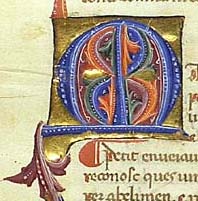
The Codex Vaticanus is regarded as the oldest extant manuscript of the Greek Bible, one of the four great uncial codices. The Codex is named after its place of conservation in the Vatican Library, where it has been kept since at least the 15th century. It is written on 759 leaves of vellum in uncial letters and has been dated palaeographically to the 4th century.

The Rossano Gospels, designated by 042 or Σ, ε 18 (Soden), at the cathedral of Rossano in Italy, is a 6th-century illuminated manuscript Gospel Book written following the reconquest of the Italian peninsula by the Byzantine Empire. Also known as Codex purpureus Rossanensis due to the reddish-purple appearance of its pages, the codex is one of the oldest surviving illuminated manuscripts of the New Testament. The manuscript is famous for its prefatory cycle of miniatures of subjects from the Life of Christ, arranged in two tiers on the page, sometimes with small Old Testament prophet portraits below, prefiguring and pointing up to events described in the New Testament scene above.

The Codex Bezae Cantabrigensis, designated by siglum Dea or 05, δ 5, is a codex of the New Testament dating from the 5th century written in an uncial hand on vellum. It contains, in both Greek and Latin, most of the four Gospels and Acts, with a small fragment of 3 John. Written one column per page, the codex contains 406 extant parchment leaves measuring 26 x 21.5 cm, with the Greek text on the left face and the Latin text on the right. A digital facsimile of the codex is available from Cambridge University Library, which holds the manuscript.

Codex Claromontanus, symbolized by Dp or 06, δ 1026, is a Greek-Latin diglot uncial manuscript of the New Testament, written in an uncial hand on vellum. The Greek and Latin texts are on facing pages, thus it is a "diglot" manuscript, like Codex Bezae Cantabrigiensis. The Latin text is designated by d or by 75 in Beuron system.

Hexapla is the term for a critical edition of the Hebrew Bible in six versions, four of them translated into Greek, preserved only in fragments. It was an immense and complex word-for-word comparison of the original Hebrew Scriptures with the Greek Septuagint translation and with other Greek translations. The term especially and generally applies to the edition of the Old Testament compiled by the theologian and scholar Origen, sometime before the year 240 CE.
Gnosticism used a number of religious texts that are preserved, in part or whole, in ancient manuscripts, or lost but mentioned critically in Patristic writings.

A biblical manuscript is any handwritten copy of a portion of the text of the Bible. The word Bible comes from the Greek biblia (books); manuscript comes from Latin manu (hand) and scriptum (written). Biblical manuscripts vary in size from tiny scrolls containing individual verses of the Jewish scriptures to huge polyglot codices containing both the Hebrew Bible (Tanakh) and the New Testament, as well as extracanonical works.

Papyrus 4 is an early New Testament papyrus of the Gospel of Luke in Greek. Opinions differ as to its age. It has been dated anywhere from the late second century to the fourth century.

The Cançoner Gil is an Occitan chansonnier produced in Catalonia in the middle of the 14th century. In the systematic nomenclature of Occitanists, it is typically named MS Sg, but as Z in the reassignment of letter names by François Zufferey. It is numbered MS 146 in the Biblioteca de Catalunya in Barcelona where it now resides.

Codex Regius designated by siglum Le or 019, ε 56, is a Greek uncial manuscript of the New Testament, dated paleographically to the 8th century. The manuscript is lacunose. It has marginalia.

Codex Campianus is designated as "M" or "021" in the Gregory-Aland cataloging system and as "ε 72" in the Von Soden system. It is a Greek uncial manuscript of the New Testament, dated palaeographically to the 9th century. The manuscript has complex contents. It has marginalia and was prepared for liturgical (religious) use.
Codex Vaticanus Graecus 2061, usually known as Uncial 048, α1 (Soden), is a Greek uncial manuscript on parchment. It contains some parts of the New Testament, homilies of several authors, and Strabo's Geographica. Formerly it was known also as the Codex Basilianus 100, earlier as Codex Patriniensis 27. It was designated by ב a, p.

Minuscule 1739, α 78, is a Greek minuscule manuscript of the New Testament, on 102 parchment leaves. It is dated paleographically to the 10th century.
Minuscule 614, α 364, is a Greek minuscule manuscript of the New Testament, on parchment. Palaeographically it has been assigned to the 13th century. The manuscript is lacunose. Tischendorf labelled it by 137a and 176p.

Codex Marchalianus designated by siglum Q is a 6th-century Greek manuscript copy of the Greek version of the Hebrew Bible known as the Septuagint. The text was written on vellum in uncial letters. Palaeographically it has been assigned to the 6th century.
Origen's Philokalia is an anthology of Origen's texts, probably compiled by Basil the Great and Gregory Nazianzen. It was probably compiled during their monastic retreat in Pontus in the late 350s to early 360s, or in any event early in their careers and before their own theological writings. The complete text of so much of Origen's work is lost, and consequently the extracts in the anthology are valuable today. It should not be confused with the medieval Philokalia.
The Sacra Parallela manuscript is a Byzantine florilegium of quotes from the Bible and patristic texts used in the instruction of ethics, morals and asceticism.
The Tractat d'Usura is a literary work written by Francesc Eiximenis in Catalan around 1374 possibly in Catalonia.
Bernat de Puigcercós (O.P.) was a Catalan Dominican friar that lived during the XIVth century. He was general Inquisitor of the Crown of Aragon.
















